
All text and images are protected under U.S copyright law.
Do not use without permission.


All text and images are protected under U.S copyright law.
Do not use without permission.

This page will discuss "Pithecanthropus 1" also called "Java Man", and demonstrate that Java man was not a man at all.

In October of 1891, Eugene Dubois discovered the cranium of "Java man" in Trinil, Java in Indonesia. ("From Lucy to Language" by Donald Johanson),


Many of the early fossil hominids were stumbled on accidentally. (pg 50 "Java man" Swisher, Curtis, Lewin)
Eugene Dubois is unique in that he was the first person to purposely search for the missing link.

The age of the cranium is believed to be ca. 500,000 years ("From Lucy to Language" by Donald Johanson), though I do not personally accept this date (see my page on carbon dating).
The biggest problem with dating the Javanese remains is that very few of the fossils were recovered in situ The young H. erectus specimen from Mojokerto is a perfect example. "If you do not know where a particular fossil was found, if you don't know which ancient sediments it was buried in, then you cannot know how old it is, because it is from the sediments, not from the fsossil itself, than an age can be determined." pg 13 "Java Man" Carl Swisher).
in situ:

| Here is how Java man has been pictured in textbooks, magazines, and museums. Is this reconstruction accurate?
How much of this reconstruction is based on actual fossils? And how much is based on an artist’s imagination? This reconstruction was based on 2 bones. The skull cap and a femur.
Dubois had his 11 year old son "...pose naked, standing unhappily in the chilly attic of an old building while Dubios sculpted a staue of Pithecanthropus erectus to be exhibited at l'Exposition Universelle in Paris in 1900."
The reconstruction seen at the right was for the World Exhibition in Paris. "The figure played no great part in the scientific disussion but it does provide a strinking illustration of the way in which Dubois viewd his mssing link" (pg. 97 "Eugene Dubois and the Ape-man from Java" by Bert Theunissen, Kluwer Academic Publishers, 1989, ISBN 1-55608-081-6 The bias of the artist is shown in Theunissens comments: "The fundamental idea underlying the reconstruction was that Pithecantropus stood half-way between ape and Man" (pg 97) It is true that Scientists do not base their theories on these pictures and museum displays, but the public is led to believe that man has evolved based in part on these convincing (sometimes misleading) displays. |
 |

Java man, like many of our so-called "evolutionary ancestors" is made up entirely from a few small bones. One of which is the skullcap seen below.
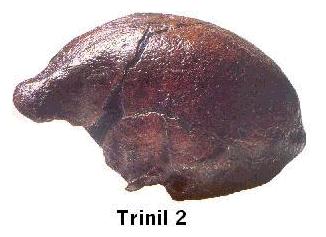

Dubois utilized 50 convicts to help him excavate ("Wisdom of the Bones" pg 41) 
In August of 1891, Dubois had shifted his search for the missing link from caves and started looking in more open areas.("Wisdom of the Bones" pg 43).
The skull cap was discovered along the banks of the Solo river.

Here is another picture of Java man showing how much of the face was reconstructed. The grey part is the skull cap that was found. The white part is how much was reconstructed.
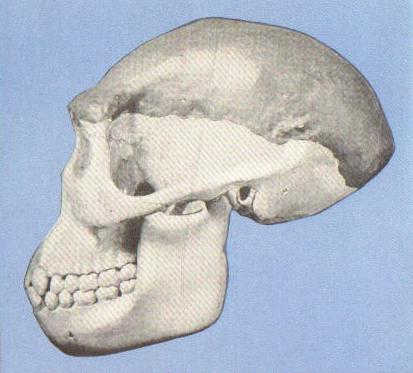

Because the skull is incomplete it is impossible to know its original size. Authorities disagree on the actual cranial capacity. Micheal Day gives 5 measurements in his book "Guide to fossil man" (fourth edition, pg 341). They are as follows:
850 cc. Boule and Vallois, 1957
900 cc. Dubois, 1924
914 cc. von Koenigswald and Weidenreich 1939
940 cc. Ashley Montagu, 1960
940 cc. Holloway 1981


Some people on both sides of the Creation / evolution debate (such as M. Lubenow and Herbert Thomas) argue that this skull can legitimately be called human based on its morphology and cranial capacity (brain size). And I agree 940 cubic centimeters is large, but that does not make it human. The rest of the section on Homo erectus will give evidence that it is not.
Marvin Lubenow believes Java man (and Homo erectus) are human. In his book "Bones of Contention" he says: "Java Man is not our evolutionary ancestor but is a true member of the human family, a post-Flood descendant of Adam, and a smaller verion of Neandertal" (pg 87, "Bones of Contention")
I disagree, see my page "Homo erectus is not a smaller version of Neanderthal"
Lubenow claims H. erectus is human, in part based on its brain size. Yet ironically in the interview he did for "In the Image of God" he says that "It is the organization of the brain, not the size that counts" (Lubenow: "In the Image of God").

At this time, none of the other bones of the head of (Trinil) Java man were found. But look how artists reconstructed the face. It looks very human like.

This is very misleading, since there is no way to know what the face looked like based on the top of the skull.
If anything they should have given Java man the face of an ape. Because the bones they did find were reminiscent of apes in every way.

Homo erectus, like many other apes, lacks a defined forehead like the ones found in humans.
"The Java skull cap shows ape-like characters in its general flattened shape, its enormous eye-brow prominence, the complete absence of what is usually called a forehead, and the small size of the brain-case."
Pg. 82 "History of the primates: An introduction to the study of fossil man" Fifth edition W. E. LeGros Clark, 1966, University of Chicago Press
The specimens from China have more of a forehead than the Javanese remains, but still nothing at all like the ones found in Homo sapiens (humans).
Chinese variants of Homo erectus have a better developed forehead region (pg 83 "History of the primates: An introduction to the study of fossil man" Fifth edition W. E. LeGros Clark, 1966, University of Chicago Press)
Speaking of Java man: "It has a long and low braincase, with no forehead and strong browridges like those of a big male apes. The back of the skull was sharply angled, rather than being smoothly rounded as in humans." ("Wisdom of the bones" pg 44)

The skull has a sessile ridge or keel along the midline. (Day 1986, pg 340). This is a feature it shares with other H. erectus specimens (Sangiran 17, Modjokerto, SM 3 etc).

Another bone of "Java man" that was found was a leg bone, shown below.

I have moved the information on the Java man femur to my page on other femurs associated with Homo erectus. If you would like to read about these femurs, please click HERE The Java man femur is actually a human femur, not a Homo erectus one.
The information on the feet of Java man has been moved to: https://www.angelfire.com/mi/dinosaurs/erectus_feet.html


The skullcap of Java man belonged to an ape (albeit an extinct one).
But its finder, Dubois saw something else.
In these few scraps of bone he saw a human ancestor, more primitive than those alive today.
In these bones he also saw his own future filled with fame and recognition. (see "Wisdom of the Bones")
These bones made Dubois famous.
There is a great misunderstanding about Java Man among both Creationists and Evolutionists. Many are under the mistaken belief that "Java man" was a mixture of human bones, with a gibbon skull. Dubois contributed to this misunderstanding himself, though some such as Weidenriech (sp) have helped perpetuate it.
While there is no question that the femur from Trinil is fully human (H. sapien), Dubois is often misquoted as having said that the Java man skullcap actually belonged to a giant gibbon.
This is simply not true, what Dubois said is that (at one time) he believed the skull belonged to an ape allied to the gibbon.

In the picture below you can see the vast difference between the Java man skullcap and that of a gibbon.
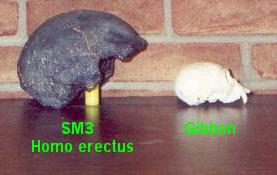
For more info on SM3 Click HERE
The Java man skullcap is much bigger than the gibbon. This does not make it a human skull. Many other apes (some now extinct) have skulls larger than a gibbons.
A close look at the anatomy of erectus shows it is not a gibbon (giant or otherwise) nor it is a human.
A big deal is made about what Dubois has said in the past about Java man. The fact is, whether Dubois said it was a giant gibbon etc it does not make it so.
Dubois merely stressed similarities in these 2 apes (erectus and a gibbon) he was not saying they were one and the same.
The limb proportions in the two are totally different. So is the shape of the skull and the rest of the body.
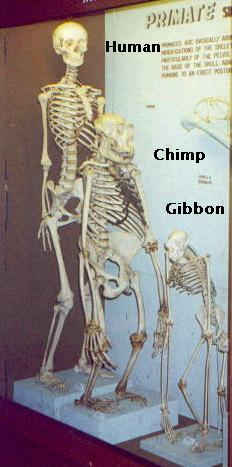

Dubois' words are not as important as the anatomy of the skull, which few who have made the claim that Trinil was a giant gibbon skull have attempted to look at.


Scientists now realize that the "Java man" remains are similar to other fossils labeled "Homo erectus", and are now classified with them.("From Lucy to Language" by Donald Johanson)
(coming soon)
Here is a picture of the Java man skull cap with Homo erectus (Homo ergaster) skull KNM-ER 3733. The similarities between the 2 suggest that it is proper to classify both the Java man (Trinil) skull cap and KNM-ER 3733 in the same species of Homo erectus.

Were other bones of Java man ever found?
"Further discoveries in Java have turned up remains from a total of about forty individuals of this species, and an equal number have come from China, mainly from the site of Zhoukoudian."("From Lucy to Language" by Donald Johanson)
For more information on the bones from Zhoukoudian, please see my page on "Peking man".

The Trinil cranium is not the only Homo erectus skull found at Java. Others include Sangiran 17 found by _ in__
| Sangarin 17 has strongly developed supraorbital torus (17mm centrally, and 13mm lateral margin of orbit)(Rightmire pg 30).
"Behind the brows, the frontal is relatively broad and flat. There is some hollowing laterally, on each side, but there is no sagittal keeling." (Rightmire pg 30). |  Here is my replica of Sangiran 17. |
Question:
"I was wondering if you could tell me anything you know about how Java man lived. For example, if they lived in groups, if they had weapons, what they ate, etc. It would be much apreciated"
- From Kate (9/25/01)
Answer:
It appears that Java man was a very complex ape, more complex than the ones we have today (Homo erectus went extinct, Australopithecines degenerated into their present form: chimps, bonobo etc). Java man is not an ape-man like many claim. God made Adam and Eve to live with this and other complex apes (which have now degenerated and are represented by todays apes - Todays apes are less complex - the opposite of evolution).
Java man was a member of the species "Homo erectus" and it appears as if they did live in groups. This can be seen from the remains at Peking China where remains of several erectus individuals are found together.
I believe they were able to make some tools, but not complex weapons. This is not so amazing, as even chimps can make tools.
As far as their diet is concerned, it appears as if some ate meat (as KNM-ER 1808 - a female erectus died from hypervitaminosis A - most likely from consuming the liver of a carnivore. Though they may have also eaten vegetation.
Check out my page on Homo erectus for more info.

 |

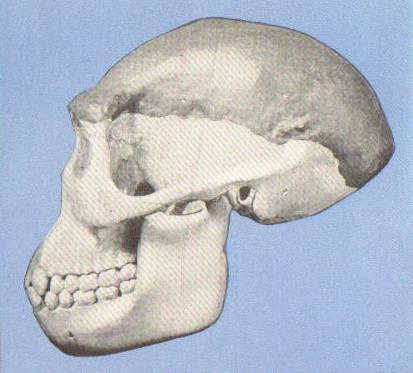
|

The Ngandong fossils appear to represent further specimens of H. erectus.


Eugene Dubois died on December 16, 1940. He was buried in an unconsecrated secton of the cemetary. His tombstone has a carving of both the Trinil skull cap and femur in the form of a skull and crossbones.
After Dubois died in 1940 his daughter Eugenie spent days burning materials she did not want to go the Dubois Archives. ("The Man who found the missing link", Pat Shipman)

References
1) "From Lucy to Language" by Donald Johanson
2) "Bones of Contention" by Marvin Lubenow
3) "Evolution: Challenge of the fossil record" by Duane T. Gish Ph.D.
4)
5) "Ancestors" by Donald Johanson, Lenora, Johanson, and Blake Edgar
If you have any questions on Creation, Evolution, or just want to say "Hi" please feel free to email me.

 | Main Index | Ape-man Index |
| Main Index | Ape-man Index | 